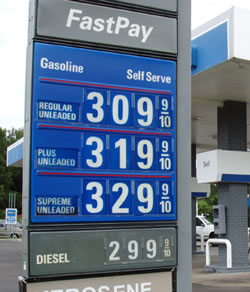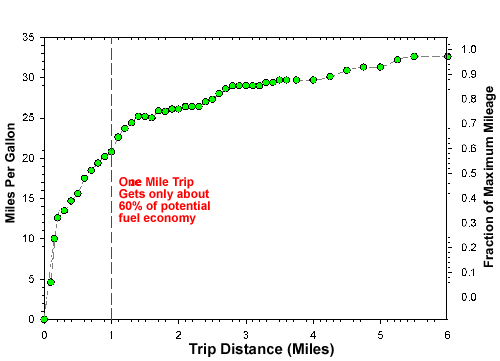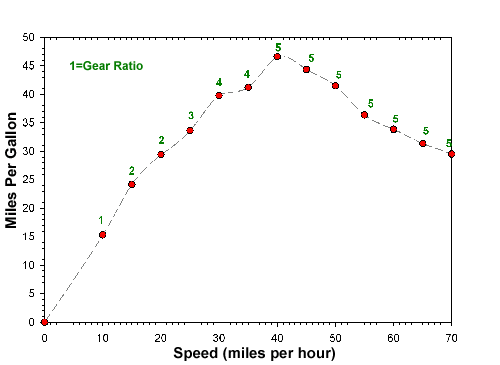
![]()
 The
following article is a substantial revision of the popular FSEC
Energy Note “Energy Efficient Transportation for Florida.” As
the price of oil passed $80 per barrel in late 2005, Danny Parker,
a Principal Research Scientist at FSEC, updated his original article
for this issue of the Energy Chronicle because of its timeliness
and importance to drivers in all parts of the country.
The
following article is a substantial revision of the popular FSEC
Energy Note “Energy Efficient Transportation for Florida.” As
the price of oil passed $80 per barrel in late 2005, Danny Parker,
a Principal Research Scientist at FSEC, updated his original article
for this issue of the Energy Chronicle because of its timeliness
and importance to drivers in all parts of the country.
Parker was also recently asked what the effects on U.S. oil imports would be if we all started driving hybrid vehicles. He crunched a few numbers and came up with the feature article Would a U.S. “Prius Lifestyle” Make an Impact on our Oil Imports? Check that story out after you finish this guide to saving money on your transportation expenses.
Energy Choices for the Road
Nearly 30 percent of the energy used in Florida is consumed by our 13 million personal automobiles that use about 7-1/2 billion gallons of gasoline every year. Florida has more registered cars per capita than any other state, with nearly one car for each person.
The average Florida automobile is driven more than 10,000 miles a year, burning about 550 gallons of gasoline and costing its owner about $1,200 in fuel costs alone at today's average prices (not to mention payments, insurance, service, repairs, tires, tags, license, etc.). Based on a comprehensive analysis, total automobile operating costs for the typical car owner average more than $800 per month.
Beyond that is the fact that the more gasoline we use, the more pollution we create. For instance, the average car that travels 10,000 miles produces 650 pounds of carbon monoxide, 105 pounds of hydrocarbons, 50 pounds of nitrogen oxides and 12 pounds of particulates. Besides saving on fuel costs and reducing pollutants, lowering automobile fuel consumption will also reduce our state's dependence on unreliable foreign oil supplies.
Consider Alternatives
So what can you do to save money on your driving costs? Consider the following:
- Park your car. Walking, riding your bicycle or using available mass transit saves energy, especially on short trips. Our test car, which gets 32 miles per gallon (mpg) on the highway, achieved only 17.1 mpg when driven on a 1.8-mile round trip to the grocery store.*
- Increase ridership. Carpooling always saves dollars and makes sense.
- Combine several errands and auto trips into one longer trip. Share errands with other household drivers.
- Use the phone to avoid wasted trips.
- Consider a bus or train for a long-distance vacation. Relax and let someone else do the driving.
- When contemplating a move, carefully consider how the location will affect your commuting distance to work, school and other weekly errands.
Choose an Efficient Automobile
For most Floridians and people in many other parts of the country — especially where reliable mass transit isn't readily available — a car is essential. Consequently, the most important single decision you can make is to choose a fuel-efficient automobile. Check out the guide at www.fueleconomy.gov to select the most efficient cars produced over the last ten years. New cars are not always more efficient than used ones. The guide gives the Environmental Protection Agency (EPA) rated mileage, both for city and highway driving.
Choosing an energy efficient car doesn't mean just buying a small car. For instance, the average fuel economy of a new car sold in the U.S. is now about 22 miles per gallon. However, if you simply bought the most efficient car in the weight class considered, the average fuel economy would immediately rise to 28 mpg.
Note that you also might consider one of the new hybrid electric-gasoline automobiles — particularly if you do a lot of stop-and-go city driving. These include the Toyota Prius (60 mpg city/51 mpg highway), the Honda Civic Hybrid (46/51) and Ford Escape Hybrid SUE (36/31). Not only do these vehicles get substantially better gas mileage, but they also do extremely well with fuel economy in around-town driving.
Avoid fuel thirsty options. These include large SUVs, heavier automobiles, larger engines/higher horsepower ("performance packages") and four-wheel drive.
Follow these suggestions for improving fuel efficiency:
- Do not use cruise control for driving in hilly regions, but instead use cruise control for improved fuel efficiency for highway driving.
- Drive your more efficient car. In households with two or more automobiles, choose the more efficient model for longer trips and more extensive driving.
- Be aware of fraud! Avoid advertised devices claiming miraculous improvements to fuel economy. The U.S. EPA has investigated more than 100 so-called gas-saving devices and products. None of these were found to significantly improve mileage. However, independent tests of oil additives containing teflon (PTFE) show modest improvements in mileage of perhaps 2 percent because engine friction is reduced.
Maintain Your Car
A car in top-running condition will achieve up to 20 percent better gas mileage than one that has not been maintained. Periodic maintenance will improve fuel efficiency and performance.
- Make sure that your tires are properly inflated. This is one of the most powerful and dependable means of improving fuel economy. Tires should be inflated to the tire manufacturer's maximum recommended pressure or the maximum recommended inflation pressure dictated for a specific car model. FSEC's test car in our original study had a 4 percent improvement in fuel economy (1.3 mpg) when the tires were inflated from 27 to 34 pounds psi.
- Keep your car tuned. A well-tuned engine can improve mileage by 3 to 9 percent. Fuel economy in our FSEC test car improved by 6 percent after a comprehensive 60,000 mile tune-up. Dirty spark plugs, air filters, pollution control valves and motor oil can cut your gas mileage.
- Reduce wind resistance. Promptly remove luggage or boat racks that will reduce fuel economy. An unused luggage rack decreased the mileage of FSEC's test car by about 0.7 mpg (2 percent) in city driving; the reduction in efficiency at freeway speeds was nearly 2 mpg (6 percent). Closed windows at freeway speeds will improve mileage by about 1 mpg (3 percent).
- Don't store unneeded things in your trunk. Golf clubs, bowling balls and other heavy items belong in the garage, not in your vehicle. A lighter car gets slightly better mileage. For every 100 pounds of extra weight in your car, your mileage will drop by about 2 to 3 percent.
- Choose energy-conserving oils. The oil you use in your car should have a label that says "energy conserving." Such oils reduce engine friction and increase fuel efficiency by 2 to 3 percent over a single-grade oil. Generally, use the lightest weight oil recommended for your car.
- Don't use fuel with an octane rating greater than your car requires. Higher octane fuel will not improve fuel efficiency. Premium gasoline is also more expensive and requires more crude petroleum for each gallon refined.

Drive Efficiently
"High efficiency driving" can substantially improve your gas mileage (see figure above). Tests conducted at FSEC showed mileage improvements of approximately 14 percent by using the following habits versus "average driving habits." The improvement was nearly 21 percent when compared to "bad driving habits," which were defined as consistently driving contrary to the recommendations below:
- Don't warm up the engine. Start it up and drive away normally.
- With a manual transmission, downshift only when necessary to accelerate the car properly. Use the brakes rather than the transmission to slow the car since using the engine wastes fuel.
- When traveling over flat rural highways, use cruise control set at a moderate speed. Most cars get their best mileage at about 45 mph. The figure below shows how the mileage of the average car falls off at faster speeds.
- Don't use cruise control for driving on hilly roads, but maintain a steady throttle.

- Don't speed. Although perhaps the least popular saving-tactic, observing the speed limit will improve your safety and increase your gas mileage. FSEC's test car gave 14 percent better gas mileage at 55 mph than at 65 mph (see the figure above illustrating this).
- Drive smart! When you see a red light ahead, brake gradually or let the car coast up to it, trying to time your arrival for the green. Alternately accelerating and braking lowers fuel economy.
- Avoid sudden acceleration and “jack-rabbit starts.” Accelerate smoothly but don't punch it. This will make an automatic transmission shift to a higher gear sooner.
- If your car has overdrive gears, use them whenever they will pull the car smoothly. Overdrive can save fuel around town, not just on the freeway. Build up speed as you approach a hill or bridge overpass.
- With a manual transmission, shift to higher gears as soon as practical without lugging the engine. Sometimes it is possible to skip fourth gear with a five-speed manual transmission. Many new cars have an indicator to move quickly and smoothly through the lower gears.
- Avoid rush-hour traffic when possible. Idling wastes fuel, your time and your patience. If you are waiting for someone or are at a drive-through, turn the engine off. It takes less fuel to start an engine than to idle for thirty seconds or more.
- Combine shorter trips into one long one.
- Park at the first available space rather than drive around to hunt for a “better” one. You'll get some exercise while saving gas and aggravation. Remember, more than 20 percent of all accidents happen in parking lots.
- Consider purchase of a gas mileage gauge (e.g. Scagauge.com) so that driving habits can be optimized.
Reduce Your Use of Auto Air Conditioning
Your car's air conditioning drains your engine's power, particularly in Florida's climate. Each time you avoid using it, you increase your mileage by between 5 to 20 percent, depending on your car and the driving conditions. It has the largest impact on efficiency when you drive around town in stop-and-go traffic. The FSEC test car used 15 percent more fuel with the air conditioner as compared to identical trips completed without its use.
- Choose a car with tinted windows and a light colored exterior to reduce the need for air conditioning. You can also have the windows tinted with solar control film.
- Try to park your car in a shady spot when possible.
- Use sunshades or car covers when your car is parked in the sun, and leave the windows open about an inch to exhaust the hot air. Monitored test cars at FSEC showed that the air temperature inside stationary automobiles without shades can reach 150°F, compared to a 15°F cooler average for cars with car shades. Using shades or car covers will improve your initial comfort and reduce the need for air conditioning.
- On hot summer days, open your car doors or windows and flush out the hot interior air for a minute or two before entering.
- When using the air conditioner, use the lowest setting at a high fan speed after the car has cooled to a comfortable level.
- The air conditioner reduces fuel economy most during acceleration. Wait to turn on your air conditioner until you have reached cruising speed.
- Some sources claim that closing windows and using a car's air conditioner will result in higher fuel economy at freeway speeds than leaving the windows open without the air conditioner. However, FSEC tests showed this is not the case. In repeated evaluations at 65 miles per hour, our test car experienced 11 percent better fuel efficiency with no A/C and the windows open rather than using the air conditioner. We also found that closing windows at freeway speeds improved fuel efficiency by 2 to 3 percent.
The Future
A number of developments will affect the efficiency of transportation in Florida's future. Hybrid gasoline-electric vehicles offer dramatically improved fuel efficiency, particularly in stop-and-go driving. These hybrid vehicles are rapidly growing in popularity, with many new battery technology developments.
Perhaps one of the most exciting areas of research is the use of hydrogen as an automotive fuel. Hydrogen has an extremely high heat content, burns cleanly and has the potential for very low engine emissions. For instance, gasoline engines operate at just below a 40 percent efficiency, whereas similar engines operating on hydrogen would operate at 50 percent or better efficiency. Hydrogen can also be produced directly from water by electrolysis, using solar electricity from photovoltaic cells. FSEC is conducting research on the production, storage and utilization of this promising fuel. While hybrid gasoline electric vehicles (HEVs) occupy the spotlight today in achieving more fuel-efficient options for personal transportation, they likely represent a transition point to the long-term solution — fuel cell automobiles. HEVs still require gasoline or diesel fuel for operation. Hybrid fuel cell vehicles potentially can wean our economy off potentially limited supplies of petroleum fuel. Burning gasoline in millions of automobiles produces massive emissions of greenhouse gases (carbon dioxide) and other effluents associated with global warming, smog and air pollution. Also, since the United States must import 60 percent of our petroleum products, continued dependence on oil still leaves the U.S. relying on countries in the Middle East and elsewhere with volatile or hostile political conditions.
Within a potential hydrogen economy, fuel cell electric vehicles (FCEVs) would utilize compressed hydrogen gas at filling stations around the country. Although the costs of the infrastructure will be very expensive, the potential benefits are equally large. Hydrogen can be produced from water by electricity from wind, solar, nuclear or gas-fired electric generation as well as from natural gas or methane. One analysis which appeared in "Science" magazine shows that hydrogen produced by electricity from wind energy would be comparable in price to current gasoline prices — although reducing the costs of the fuel cells themselves remains a challenging task. Fuel cell powered automobiles are under rapid development now. For instance, a project in California will soon see 35 Toyota Prius models converted to run on hydrogen with fuel cells. Honda also has introduced the first fuel cell-powered automobile in North America — the FCX. Ford, DaimlerChrysler, GM and BMW are also soon to be deploying fuel cell-powered automobiles in the U.S. in the near future.
The trip to work is changing too. Newly available communication equipment can reduce the daily travel to offices. Telecommuting can reduce energy use and air pollution. And as Florida becomes more urbanized, we can expect to see more transit options. Buses, trolleys, monorails and high-speed trains may serve Florida's largest cities.
With adequate planning, Florida's future transportation needs can be met with less waste of our resources. Use the tips presented here to save energy now, and be open-minded to new vehicles, innovative work habits and new transit options. Transportation energy efficiency can keep us moving to a better future for everyone.
Selected References
"A Guide to Saving Gasoline," Consumer's Research, November, 1990.
D. Parker, "Some Measured Influences on Automobile Gasoline Mileage," Florida Solar Energy Center, FSEC Research Report RR-25, Cocoa, FL, December, 1991.
Bob Rackleff, “The Economic Drag of Florida's Over Reliance on Personal Vehicle Transportation,” National Association of Counties Legislative Conference, March 3, 2000.
U.S. Department of Energy, 1982-1992 Gas Mileage Guides , DOE/CE-0019/10, Washington, D.C.
U.S. Department of Energy, Fuel Economy Guide, 2005, Washington, D.C. www.fueleconomy.gov .
Alexandra Baker, "Fuel Cell Market Survey: Automotive Hydrogen Infrastructure," Fuel Cell Today, May 25, 2005.
M. Z. Jacobson, W. G. Colella, D. M. Golden, "Cleaning the Air and Improving Health with Hydrogen Fuel Cell Vehicles," Science, June 24, 2005
http://www.stanford.edu/group/efmh/jacobson/SciencePubHyd.pdf
*At FSEC in the 1990s, we tested many of the tips associated with improving automobile efficiency to verify the savings potential. We used a 1986 Volkswagen GTI, which has an on-board computer, to track instantaneous and trip mileage. This automobile has a nominal EPA mileage rating of 28 miles per gallon in the city and 32 on the highway.
